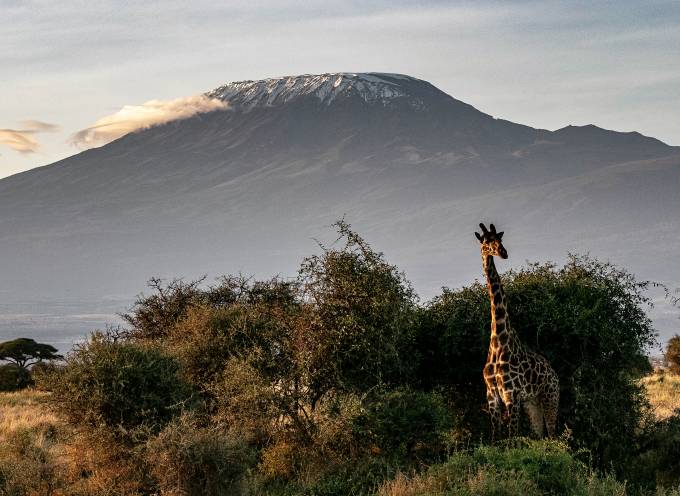
Big Five Safari Tours
If you’re planning a safari holiday, you’ll no doubt have the Big Five on your bucket list. Whether it’s the challenge of spotting them or just the hype surrounding their existence, these fascinating animals provide intriguing facts and stunning pictures. The five fabulous game animals of Africa are guaranteed to make your African Big Five safari tour feel out-of-this-world and totally magical.
How to Spot the Big Five
Going on a safari is an experience like no other, whether you're sitting in a jeep or riding on the back of a horse, getting to see some of the world’s most unique animals is a dream come true.

Jeep tour
Rugged and tough, these 4X4s are usually open-roofed so that everyone has a panoramic view. With the ability to track and get close to animals, a jeep safari enables you to capture those perfect pictures of the Big Five. Jeep tours in Africa >>
Horse safari
Gallivanting alongside zebras and getting so close to the Big Five that you can hear them crunching on acacia leaves is an invigorating experience. Although horseback riding is not the most comfortable, the whole experience is transformed when you realise that you are not just simply a spectator, you are a participant. African horse safaris >>
Bush walk
Exploring the bush on foot opens a whole new world. You feel as vulnerable as prey but also become more aware as you literally walk in the footsteps of animals. There’s nothing like an encounter with the Big Five on foot, the excitement and thrill of hiding meters away is something you'll never forget. Walking safaris >>
Balloon ride
Departing at sunrise, a hot air balloon provides a superb view of the plains. Flying low over big herds make this one of the best ways to witness the Great Migration. Despite the early wake-up call and freezing temperatures, remaining unnoticed by the Big Five makes the experience completely worth it. Balloon safaris >>

By plane
With spectacular scenes and astonishing views, a bush plane is a time-efficient way of hopping between game reserves. Although the planes are loud and can scare away wildlife, remaining a good distance away creates breathtaking panoramic shots of the Big Five while adding a layer of thrill and excitement. Fly-in safaris >>
The Big 5: Facts You Need To Know
We have compiled a list of facts about the Big Five and tips for your safari so that you can show off your African wildlife knowledge on your next adventure!
How likely am I going to see all members of the Big Five?
The Big Five are elusive creatures and are generally hard to spot on just one game drive. To maximize your chances of seeing all of the members, we recommend that you book a Big Five tour that contains several game drives at multiple national parks.
How can I increase the chance to spot the Big Five?
To spot all five of these animals in one day is a rare occurrence. To maximise your chances, having a guide that knows how the animals hunt, move, think and where they drink is highly advantageous. Embarking on a professional multi-day tour allows you plenty of time to search for these elusive animals.
Why are they called the Big Five?
The term "Big Five" was created as these creatures were chosen as the crème de la crème of African wildlife not because of their size, scarcity, or magnificence, but because they were elected as the five most difficult species to hunt on foot.
Which one is the biggest predator?
Physically, the biggest predator of the Big Five is the elephant. Since elephants form tight herds it is hard for predators to get them alone unless one falls behind the rest. In general, elephants are very healthy so it isn’t often that one is able to become a meal for other predators.
Which of the Big Five is most difficult to spot?
The leopard is one of the most alluring, secretive and graceful of the Big Five and is the most difficult to find. After hunting, leopards drag their prey up into the branches of trees to keep scavengers away, which makes spotting them a challenge as they normally sprawl underneath low-hanging trees.
What precautions should I take?
It's no secret that the Big Five are potentially dangerous, but as long as you listen to your guide, there is little to worry about. Always maintain a safe distance from the animals and for extra caution wear neutral clothes. It's also important to note that hippos are more dangerous than any of the Big Five.
What are the Big Seven animals in Africa?
Witnessing the Big Five animals of Africa is a prominent feature on many bucket lists. The southern right whale and the great white shark are the two most sought after ocean species to spot while cruising the African coastline and have therefore been added to the list to create the Big Seven.
What are the Little Five?
The Big Five are impressive, but there is also a wealth of interesting smaller species roaming the plains. In particular, the elephant shrew, ant lion, rhinoceros beetle, buffalo weaver and leopard tortoise form Africa's Little Five. A bush walk is optimal to check these intriguing creatures off of your safari list.
What Are the Big Five Safari Animals?
Making their way onto every traveller wish list, the Big Five of Africa are safari royalty. Snapping pictures of these remarkable animals strolling on dusty desert plains will be a cherished memory.

Elephant
African elephants are one of the most social animals living in groups of up to a hundred individuals. The largest living land mammal presents a truly remarkable sight, especially when you witness them wandering in their impressive herds.
Conservation status: Vulnerable
Weight: 6,000 kg
Lifespan: 60 to 70 years
Rhino
A black rhinoceros wandering desert plains looks almost prehistoric, a creature from days long ago. Listed as critically endangered due to poaching, only a handful of rhinos remain in the wild. In the midday sun, rhinos are spotted sleeping in the shade or bathing in muddy pools to cool down.
Conservation status: Critically endangered
Weight: 800 to 1,400 kg
Lifespan: 35 to 50 years
Buffalo
They may be referred to as bush cows, but don't let that fool you. Cape buffalos are powerful, quick and ruthless predators. Their curved horns effectively cover the top of their head, forming a shield that makes them virtually indestructible.
Conservation status: Least concern
Weight: 590 kg
Lifespan: 20 years
Lion
Lions are the kings of the animal kingdom, and it’s not hard to see why. You may be lucky enough to see a pride of African lions catching some sunlight on the kopjes that dot the grasses of the Serengeti, scouring the plains, like kings and queens on their thrones.
Conservation status: Vulnerable
Weight: 130 to 190 kg
Lifespan: 10 to 4 years
Leopard
African leopards are cunning, nocturnal animals which makes any sighting a rare treat. Leopards are usually seen lounging on branches of trees. The treetops aren’t just a leopard’s bed but also a kitchen and they regularly drag their prey up into the branches to keep scavengers away.
Conservation status: Vulnerable
Weight: 17 to 65 kg
Lifespan: 12 to 15 years
Choose Your Start City for Your Big Five Safari
Africa is a land full of lively cities, wild coasts and captivating landscapes, a perfect base for any safari tour. Select a departing city for the adventure of a lifetime.
Book your Safari tour today!
+1 844 311 8331
24/7 Support
Our team of experienced Travel Experts have travelled to hundreds of countries around the globe and have decades of first-hand travel experience to share. Contact us now to have all of your tour-related questions answered!
Big Five Safari Tour Operators

Africa Natural Tours
42 reviews

Gracepatt Ecotours Kenya
41 reviews

Beach and Safari Holidays
2 reviews

On The Go Tours
2,207 reviews

Acacia Adventure Holidays
283 reviews

Across Africa Tours & Travel
106 reviews

Professional Safari Africa
20 reviews

G Adventures
13,818 reviews

Samson's Safaris
1 review

African Polecat Safaris
92 reviews

Absolute Africa
173 reviews

Intrepid Travel
8,941 reviews

Prime Safaris
8 reviews

journaway
85 reviews

Classic Journeys Africa Ltd
36 reviews

Pam Tours and Travel
22 reviews

Exciting Africa Holidays
63 reviews

Travel Africa Safari Agency
155 reviews















































